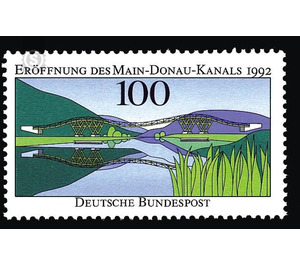Opening of the Main-Danube Canal 1992 - Germany / Federal Republic of Germany 1992 - 100 Pfennig
Theme: Architecture
| Country | Germany / Federal Republic of Germany |
| Issue Date | 1992 |
| Face Value | 100.00 |
| Color | multi-colored blue |
| Perforation | K 14 |
| Printing Type | Multicolor offset printing |
| Stamp Type | Postage stamp |
| Item Type | Stamp |
| Chronological Issue Number | 1503 |
| Chronological Chapter | GER-BRD |
| SID | 375037 |
| In 42 Wishlists | |
With the completion of the Main-Danube Canal, a waterway and shipping route is being developed across Europe that stretches from the North Sea to the Black Sea. With this building, a more than 1,000-year-old dream of Europe is realized. The resulting connection of the Rhine-Main route with the Danube region will connect nine European states even more closely over a length of 3,500 km. Bavaria, on whose soil the canal was created, thus also has the function of a link between East and West in inland navigation. The opening of the Main-Danube Canal is a visible sign of the new European bond. The countries of Eastern Europe now also have access to the countries of the European Community via an internal shipping route. The completion of the Main-Danube Canal is a great success for the client, Rhein-Main-Donau AG. It has brought the largest traffic project in Germany to a good conclusion and thus proved its competence. The government of the Free State of Bavaria, which had to push through the project again and again against political resistance and termination attempts, sees the opening of the channel in a changed transport environment, which assigns increased importance to inland navigation and east-west traffic, rewarding their foresight. The Main-Danube Canal itself extends over a length of 171 km from Bamberg to Kelheim and has 16 locks. In nearly 30 years of construction nearly 4 billion DM were spent on the construction of the canal. The construction of the canal will be financed from RMD's own resources, which flow from the use of water resources, and from borrowings, including interest-free loans from the federal government and the Free State of Bavaria. On the canal, up to 14 million tons of goods can be transported per year on European ships or by means of push barges with two barges (max. 3,300 tons). In the course of the European internal market and the opening of the East, the volume of goods carried in East-West traffic will increase significantly. In view of already crowded roads and limited railway capacities, the transport capacity available on the Rhine-Main-Danube waterway therefore plays an important role. These factors will contribute to a good utilization of the Main-Danube Canal. The Main Danube Canal is a national waterway. Within the framework of the European internal market, the canal is open to shipping companies from all EC Member States. The ships of Eastern European countries may use the channel on the basis and in accordance with contractual agreements of the Federal Government with the respective governments. Such inland waterway agreements are already concluded with most Eastern European countries. A major project, such as the construction of the Main-Danube Canal, inevitably brings with it impairments to the natural balance and changes in the landscape. By means of landscaping accompanying planning, a new landscape was created through the necessary compensation and replacement measures. The trouble was worth it. The altered by the channel Altmühltal z. B. is already recording above-average increases in guest numbers. The inland vessel has many advantages over other modes of transport. It is by far the cheapest and also a very safe means of mass transport, it is energy efficient, low noise and environmentally friendly. Following the opening of the Main-Danube Canal, a new transport route will be available to help effectively solve the growing traffic problems in the future. (Text: Bavarian Ministry of Economic Affairs and Transport, Munich)


